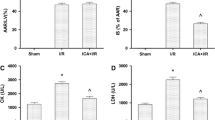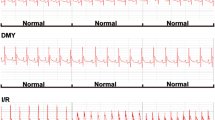Abstract
Preconditioning with Peoniflorin, a component of traditional Chinese prescriptions, was proposed to be a potential strategy for cardioprotection against ischemia/reperfusion (I/R) injury. However, the cardioprotective effect of Peoniflorin preconditioning has not been thoroughly confirmed, and the underlying mechanism remains unclear. Here, we examined the cardioprotective effect and its mechanism of Peoniflorin preconditioning against myocardial I/R injury. Rats were subjected to 30 min of transient ischemia followed by 2 h of reperfusion with or without Peoniflorin (100 mg/kg) prior to reperfusion. Peoniflorin preconditioning significantly limited myocardial infarct size and reperfusion arrhythmias, as well as obviously attenuated the histomorphological and micromorphological damages induced by I/R injury. The reduced myocardial injury was also associated with the anti-apoptotic effect of Peoniflorin, as evidence by decreased TUNEL-positive cells, upregulation of BCL-2 expression, and downregulation of Bax and caspase-3 expression. In an effort to evaluate the mechanism responsible for the observed cardioprotective and anti-apoptotic effect, Western blot of phosphorylated protein was performed after 20 min of reperfusion. Results showed that Peoniflorin preconditioning activated both the Akt and ERK1/2 arm of the reperfusion injury salvage kinase (RISK) pathway. To further confirm this mechanism, the PI3K signaling inhibitor LY294002 and ERK1/2 signaling inhibitor PD98059 were administered in vivo. The cardioprotective and anti-apoptotic effects of Peoniflorin preconditioning were diminished but not abolished by pretreatment with LY294002 or PD98059. Taken together, these results indicate that Peoniflorin preconditioning protects the myocardial against I/R injury and inhibits myocardial apoptosis via the activation of the RISK pathway, highlighting the potential therapeutic effects of Peoniflorin on reducing myocardial I/R injury.








Similar content being viewed by others
Data Availability
Not applicable
References
Hillis, L. D., & Lange, R. A. (2006). Myocardial infarction and the open-artery hypothesis. New England Journal of Medicine, 355, 2475–2477. https://doi.org/10.1056/NEJMe068251
Rodriguez-Sinovas, A., Abdallah, Y., Piper, H. M., & Garcia-Dorado, D. (2007). Reperfusion injury as a therapeutic challenge in patients with acute myocardial infarction. Heart Failure Reviews, 12, 207–216. https://doi.org/10.1007/s10741-007-9039-9
Hausenloy, D. J., & Yellon, D. M. (2007). Preconditioning and postconditioning: United at reperfusion. Pharmacology and Therapeutics, 116, 173–191. S0163-7258(07)00125-8.
Staat, P., Rioufol, G., Piot, C., Cottin, Y., Cung, T. T., L’Huillier, I., Aupetit, J. F., Bonnefoy, E., Finet, G., Andre-Fouet, X., & Ovize, M. (2005). Postconditioning the human heart. Circulation, 112, 2143–2148. CIRCULATIONAHA.105.558122.
Heusch, G., Botker, H. E., Przyklenk, K., Redington, A., & Yellon, D. (2015). Remote ischemic conditioning. Journal of the American College of Cardiology, 65, 177–195. https://doi.org/10.1016/j.jacc.2014.10.031
Hahn, J. Y., Song, Y. B., Kim, E. K., Yu, C. W., Bae, J. W., Chung, W. Y., Choi, S. H., Choi, J. H., Bae, J. H., An, K. J., Park, J. S., Oh, J. H., Kim, S. W., Hwang, J. Y., Ryu, J. K., Park, H. S., Lim, D. S., & Gwon, H. C. (2013). Ischemic postconditioning during primary percutaneous coronary intervention: The effects of postconditioning on myocardial reperfusion in patients with ST-segment elevation myocardial infarction (POST) randomized trial. Circulation, 128, 1889–1896. https://doi.org/10.1161/CIRCULATIONAHA.113.001690
Ibanez, B., Heusch, G., Ovize, M., & Van de Werf, F. (2015). Evolving therapies for myocardial ischemia/reperfusion injury. Journal of the American College of Cardiology, 65, 1454–1471. S0735-1097(15)00669-5.
Fernandez-Jimenez, R., & Ibanez, B. (2015). CAESAR: One step beyond in the construction of a translational bridge for cardioprotection. Circulation Research, 116, 554–556. https://doi.org/10.1161/CIRCRESAHA.115.305841
Garcia-Dorado, D., Garcia-del-Blanco, B., Otaegui, I., Rodriguez-Palomares, J., Pineda, V., Gimeno, F., Ruiz-Salmeron, R., Elizaga, J., Evangelista, A., Fernandez-Aviles, F., San-Roman, A., & Ferreira-Gonzalez, I. (2014). Intracoronary injection of adenosine before reperfusion in patients with ST-segment elevation myocardial infarction: A randomized controlled clinical trial. International Journal of Cardiology, 177, 935–941. https://doi.org/10.1016/j.ijcard.2014.09.203
Jones, S. P., Tang, X. L., Guo, Y., Steenbergen, C., Lefer, D. J., Kukreja, R. C., Kong, M., Li, Q., Bhushan, S., Zhu, X., Du, J., Nong, Y., Stowers, H. L., Kondo, K., Hunt, G. N., Goodchild, T. T., Orr, A., Chang, C. C., Ockaili, R., … Bolli, R. (2015). The NHLBI-sponsored Consortium for preclinicAl assESsment of cARdioprotective therapies (CAESAR): A new paradigm for rigorous, accurate, and reproducible evaluation of putative infarct-sparing interventions in mice, rabbits, and pigs. Circulation Research, 116, 572–586. https://doi.org/10.1161/CIRCRESAHA.116.305462
Chou, T. C. (2003). Anti-inflammatory and analgesic effects of paeonol in carrageenan-evoked thermal hyperalgesia. British Journal of Pharmacology, 139, 1146–1152. https://doi.org/10.1038/sj.bjp.0705360
Ye, J., Duan, H., Yang, X., Yan, W., & Zheng, X. (2001). Anti-thrombosis effect of paeoniflorin: Evaluated in a photochemical reaction thrombosis model in vivo. Planta Medica, 67, 766–767. https://doi.org/10.1055/s-2001-18364
Qian, G. Q., Ding, J., Zhang, X., Yin, X., Gao, Y., & Zhao, G. P. (2015). Preconditioning with glycyrrhizic, ferulic, paeoniflorin, cinnamic prevents rat hearts from ischemia/reperfusion injury via endothelial nitric oxide pathway. Pharmacognosy Magazine, 11, 292–296. https://doi.org/10.4103/0973-1296.153081
Hsieh, C. L., Cheng, C. Y., Tsai, T. H., Lin, I. H., Liu, C. H., Chiang, S. Y., Lin, J. G., Lao, C. J., & Tang, N. Y. (2006). Paeonol reduced cerebral infarction involving the superoxide anion and microglia activation in ischemia-reperfusion injured rats. Journal of Ethnopharmacology, 106, 208–215. S0378-8741(05)00846-9.
Chen, Y. F., Wu, K. J., & Wood, W. G. (2013). Paeonia lactiflora extract attenuating cerebral ischemia and arterial intimal hyperplasia is mediated by paeoniflorin via modulation of VSMC migration and Ras/MEK/ERK signaling pathway. Evidence-based Complementary and Alternative Medicine, 2013, 482428. https://doi.org/10.1155/2013/482428
Guo, R. B., Wang, G. F., Zhao, A. P., Gu, J., Sun, X. L., & Hu, G. (2012). Paeoniflorin protects against ischemia-induced brain damages in rats via inhibiting MAPKs/NF-kappaB-mediated inflammatory responses. PLoS One, 7, e49701. https://doi.org/10.1371/journal.pone.0049701
Nizamutdinova, I. T., Jin, Y. C., Kim, J. S., Yean, M. H., Kang, S. S., Kim, Y. S., Lee, J. H., Seo, H. G., Kim, H. J., & Chang, K. C. (2008). Paeonol and paeoniflorin, the main active principles of Paeonia albiflora, protect the heart from myocardial ischemia/reperfusion injury in rats. Planta Medica, 74, 14–18. https://doi.org/10.1055/s-2007-993775
Qian, G. Q., Peng, X., Cai, C., & Zhao, G. P. (2014). Effect on eNOS/NO pathway in MIRI rats with preconditioning of GFPC from Dang Gui Si Ni decoction. Pharmacognosy Research, 6, 133–137. https://doi.org/10.4103/0974-8490.129032
Hausenloy, D. J., & Yellon, D. M. (2007). Reperfusion injury salvage kinase signalling: Taking a RISK for cardioprotection. Heart Failure Reviews, 12, 217–234. https://doi.org/10.1007/s10741-007-9026-1
Badalzadeh, R., Mokhtari, B., & Yavari, R. (2015). Contribution of apoptosis in myocardial reperfusion injury and loss of cardioprotection in diabetes mellitus. The Journal of Physiological Sciences, 65, 201–215. https://doi.org/10.1007/s12576-015-0365-8
Weinreuter, M., Kreusser, M. M., Beckendorf, J., Schreiter, F. C., Leuschner, F., Lehmann, L. H., Hofmann, K. P., Rostosky, J. S., Diemert, N., Xu, C., Volz, H. C., Jungmann, A., Nickel, A., Sticht, C., Gretz, N., Maack, C., Schneider, M. D., Grone, H. J., Muller, O. J., … Backs, J. (2014). CaM kinase II mediates maladaptive post-infarct remodeling and pro-inflammatory chemoattractant signaling but not acute myocardial ischemia/reperfusion injury. EMBO Molecular Medicine, 6, 1231–1245. https://doi.org/10.15252/emmm.201403848
Walker, M. J., Curtis, M. J., Hearse, D. J., Campbell, R. W., Janse, M. J., Yellon, D. M., Cobbe, S. M., Coker, S. J., Harness, J. B., Harron, D. W., et al. (1988). The Lambeth Conventions: Guidelines for the study of arrhythmias in ischaemia infarction, and reperfusion. Cardiovascular Research, 22, 447–455.
Curtis, M. J. (1998). Characterisation, utilisation and clinical relevance of isolated perfused heart models of ischaemia-induced ventricular fibrillation. Cardiovascular Research, 39, 194–215.
Ghaboura, N., Tamareille, S., Ducluzeau, P. H., Grimaud, L., Loufrani, L., Croue, A., Tourmen, Y., Henrion, D., Furber, A., & Prunier, F. (2011). Diabetes mellitus abrogates erythropoietin-induced cardioprotection against ischemic-reperfusion injury by alteration of the RISK/GSK-3beta signaling. Basic Research in Cardiology, 106, 147–162. https://doi.org/10.1007/s00395-010-0130-3
Orogo, A. M., & Gustafsson, A. B. (2013). Cell death in the myocardium: My heart won’t go on. IUBMB Life, 65, 651–656. https://doi.org/10.1002/iub.1180
Kloner, R. A., Ellis, S. G., Lange, R., & Braunwald, E. (1983). Studies of experimental coronary artery reperfusion. Effects on infarct size, myocardial function, biochemistry, ultrastructure and microvascular damage. Circulation, 68, I8-15.
Ma, L. L., Zhang, F. J., Qian, L. B., Kong, F. J., Sun, J. F., Zhou, C., Peng, Y. N., Xu, H. J., Wang, W. N., Wen, C. Y., Zhu, M. H., Chen, G., Yu, L. N., Liu, X. B., Wang, J. A., & Yan, M. (2013). Hypercholesterolemia blocked sevoflurane-induced cardioprotection against ischemia-reperfusion injury by alteration of the MG53/RISK/GSK3beta signaling. International Journal of Cardiology, 168, 3671–3678. https://doi.org/10.1016/j.ijcard.2013.06.037
Penna, C., Settanni, F., Tullio, F., Trovato, L., Pagliaro, P., Alloatti, G., Ghigo, E., & Granata, R. (2013). GH-releasing hormone induces cardioprotection in isolated male rat heart via activation of RISK and SAFE pathways. Endocrinology, 154, 1624–1635. https://doi.org/10.1210/en.2012-2064
Somers, S. J., Frias, M., Lacerda, L., Opie, L. H., & Lecour, S. (2012). Interplay between SAFE and RISK pathways in sphingosine-1-phosphate-induced cardioprotection. Cardiovascular Drugs and Therapy, 26, 227–237. https://doi.org/10.1007/s10557-012-6376-2
Garcia-Prieto, J., Garcia-Ruiz, J. M., Sanz-Rosa, D., Pun, A., Garcia-Alvarez, A., Davidson, S. M., Fernandez-Friera, L., Nuno-Ayala, M., Fernandez-Jimenez, R., Bernal, J. A., Izquierdo-Garcia, J. L., Jimenez-Borreguero, J., Pizarro, G., Ruiz-Cabello, J., Macaya, C., Fuster, V., Yellon, D. M., & Ibanez, B. (2014). Beta3 adrenergic receptor selective stimulation during ischemia/reperfusion improves cardiac function in translational models through inhibition of mPTP opening in cardiomyocytes. Basic Research in Cardiology, 109, 422. https://doi.org/10.1007/s00395-014-0422-0
Meng, X. B., Sun, G. B., Wang, M., Sun, J., Qin, M., & Sun, X. B. (2013). P90RSK and Nrf2 activation via MEK1/2-ERK1/2 pathways mediated by notoginsenoside R2 to prevent 6-hydroxydopamine-induced apoptotic death in SH-SY5Y Cells. Evidence-based Complementary and Alternative Medicine, 2013, 971712. https://doi.org/10.1155/2013/971712
Funding
This study was supported by grants from the National Natural Science Foundation of China (No. 81673787), the Natural Science Foundation of Shaanxi (No. 2014JM2-8160), and the Medical Research Project of Xi’an Technology and Social Development Guiding Plan (No. SF1416).
Author information
Authors and Affiliations
Contributions
The authors contributed equally.
Corresponding author
Ethics declarations
Ethics Approval
Not applicable
Consent to Participate
All authors have their consent to participate.
Consent for Publication
All authors have their consent to publish their work.
Competing Interests
The authors declare no competing interests.
Additional information
Publisher's Note
Springer Nature remains neutral with regard to jurisdictional claims in published maps and institutional affiliations.
Supplementary Information
Below is the link to the electronic supplementary material.
Rights and permissions
About this article
Cite this article
Ma, H., Hao, J., Liu, H. et al. Peoniflorin Preconditioning Protects Against Myocardial Ischemia/Reperfusion Injury Through Inhibiting Myocardial Apoptosis: RISK Pathway Involved. Appl Biochem Biotechnol 194, 1149–1165 (2022). https://doi.org/10.1007/s12010-021-03680-z
Received:
Accepted:
Published:
Issue Date:
DOI: https://doi.org/10.1007/s12010-021-03680-z




